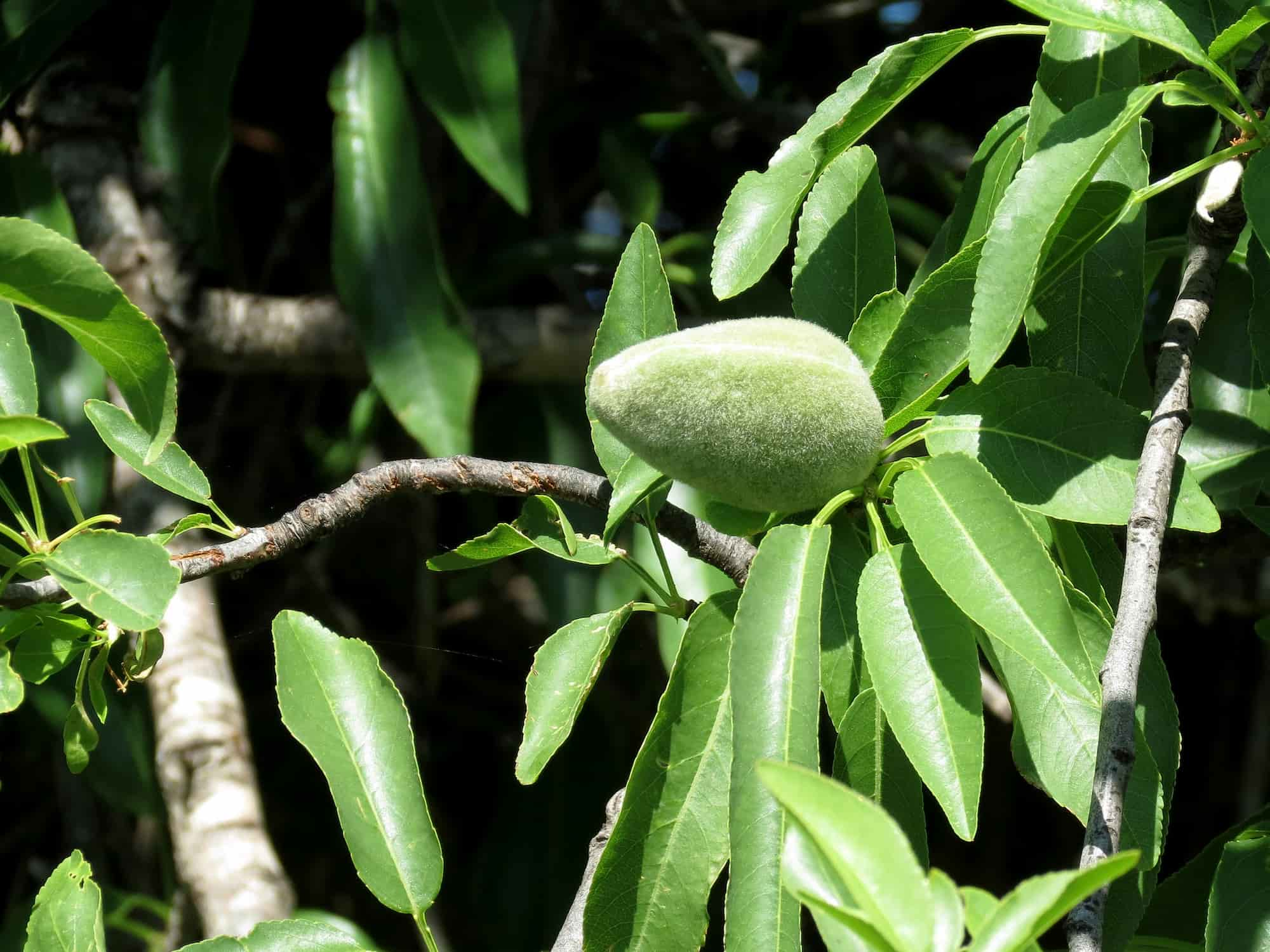
Almond tree: planting, pruning, harvesting
Contents
The almond tree in a nutshell
- It is the first fruit tree to bloom. From the end of winter, in February, or even January for some varieties, it is covered in pale pink flowers.
- While the almond tree is hardy down to -25 °C, its early flowers are susceptible to spring frosts.
- The almond tree produces velvety drupes that contain an inner stone with one or two edible seeds, the delicious almonds.
- The almond tree prefers light, well-drained soils with a tendency towards limestone. It requires full sun.
- A quintessential Mediterranean tree, it easily withstands drought.
A word from our expert
Ah, the sweet scent of almond trees heralding spring… As the first tree to bloom, the almond tree (Prunus dulcis syn. Prunus amygdalus) is adorned with small flowers of a lovely pinkish white from January or February. These highly nectariferous flowers are a true boon for pollinating insects freshly emerged from their winter slumber. Then the leaves appear.
Between late July and October, the almond tree produces drupes with a velvety touch that conceal a treasure: the famous almonds which are used in countless ways—culinary, cosmetic, medicinal, and even in furniture…
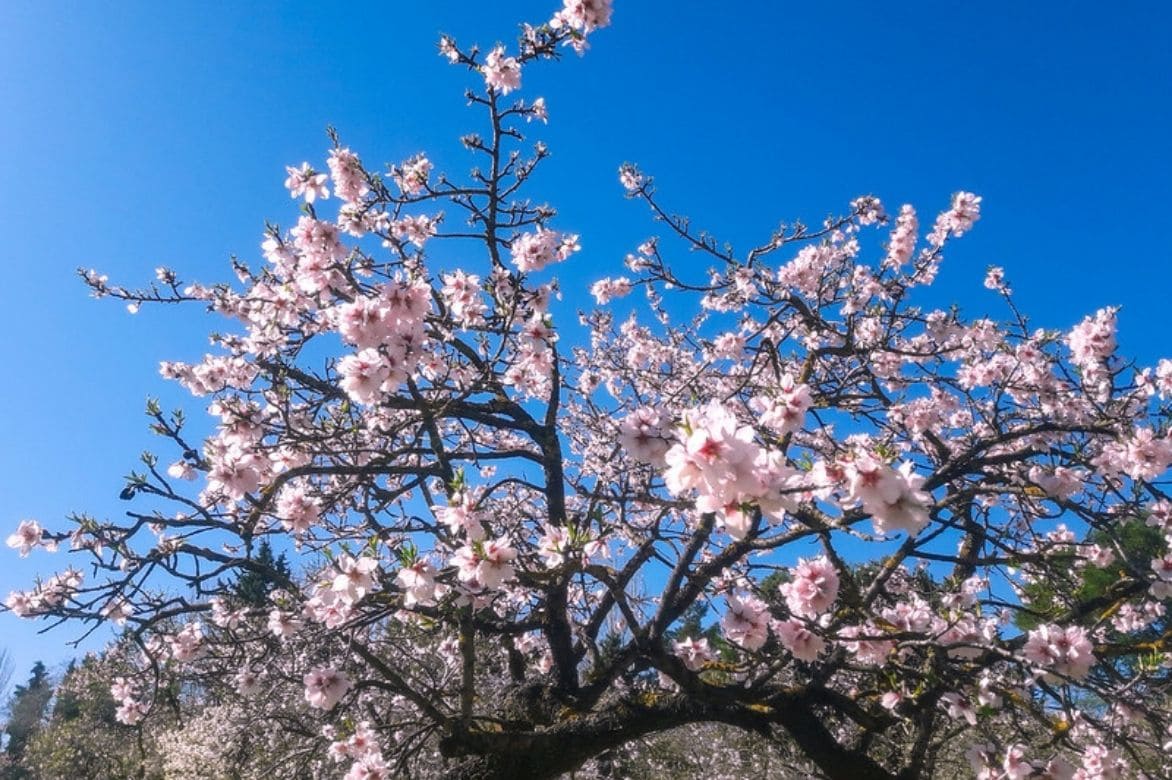
The almond tree announces spring with its early flowering, but is susceptible to late frosts
A member of the Rosaceae family, the almond tree is likely native to Asia. Known since ancient times, it is mentioned in the Old Testament and appears in ancient paintings in Pompeii. Introduced to Italy as early as the 3rd century, it only reached the south of France in the 16th century, where it has perfectly acclimatised. Over the centuries, it has become one of the emblematic trees of the Aix region, thanks to the delicious calissons.
While the wild almond tree produces bitter almonds, which are high in amygdalin, numerous horticultural selections and the domestication of the tree have led to the creation of many varieties of almond tree with sweet almonds.
With a spreading habit that rounds out with age and a rough trunk, the almond tree makes a beautiful ornamental tree.
Botany
Botanical data
- Latin name Prunus dulcis syn. Prunus amygdalus
- Family Rosaceae
- Common name almond tree, common almond
- Flowering spring
- Height 6 to 10 m
- Exposure full sun
- Soil type light and well-drained
- Hardiness Hardiness down to -25 °C (except for frost-sensitive flowers)
Prunus dulcis, formerly known as Amygdalus communis, is a tree in the Rosaceae family, which also includes many of our fruit trees such as apple, pear, cherry, and service trees, as well as strawberries, raspberries, and roses.
Most likely originating from Central or Western Asia, the almond tree was cultivated early on in the Greek islands and then throughout Southern Europe and North Africa. Mentioned in the Old Testament, it was gradually domesticated. It is also referenced in Carolingian and Merovingian documents. By the mid-19th century, it crossed the Atlantic to be established in California, which is now the leading producer of almonds. This has had regrettable environmental consequences… In France, the almond tree is mainly found in Provence, as it thrives in warm climates with plenty of sunshine. This region is particularly ideal as late spring frosts are rare. According to local lore, it may have been introduced as early as the 5th century BC. Nevertheless, by the Middle Ages, Aix-en-Provence became the centre of almond production and Provençal confectionery. The almond is indeed one of the 13 traditional desserts served on Provençal tables for Christmas dinner.
The domestication of wild almond trees and selective breeding have led to the creation of sweet almond varieties (Prunus dulcis), although bitter almond varieties can still be found.
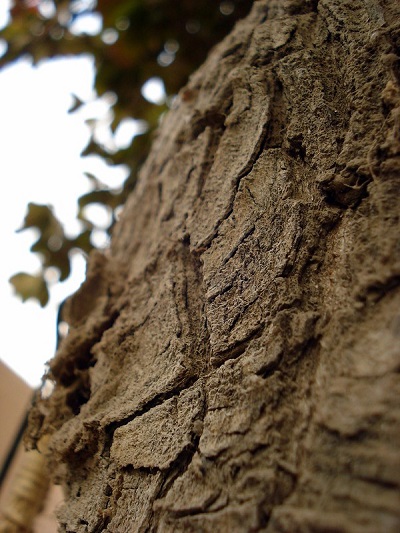 The trunk of the almond tree is rough
The trunk of the almond tree is rough
The almond tree is a beautiful tree that can reach heights of 8 to 12 metres, but more commonly 5 to 6 metres. It enjoys rapid growth in the first few years after planting. Hardy down to -25 °C, it can potentially be planted anywhere in France. However, it fruits best in the south of France. Indeed, as the almond tree has the unique characteristic of flowering as early as the end of winter, late frosts, whether winter or spring, can be fatal as they compromise fruiting. Some late-flowering varieties can, however, be planted north of the Loire, provided they are grown in a well-sunny location and especially sheltered from cold winds.
The almond tree has an upright, spreading habit that tends to round out with age. Generally, it lives for 70 to 80 years, or even 100 years if the growing conditions are favourable. Its trunk is rough, twisted in appearance, covered with ash-grey, twisted bark that flakes off in patches. Its twigs, light green at first, turn reddish in the sun.
The almond tree is a deciduous tree. The upper surface of the leaves is dark green and shiny, with slight metallic reflections, while the underside is greyish-green. The alternate leaves are narrow and 12 to 14 cm long, elliptical-lanceolate, rather glabrous, and briefly petiolate. They have fine serrations along the edges and are longitudinally folded during development. The buds are also reddish and pointed.
The flowers appear before the leaves, during a period extending from late winter (January-February) to early spring (March). It is indeed one of the first trees to flower, heralding the arrival of spring. Its flowers are white tinged with pink, solitary or geminate, and almost sessile. They are grouped in clusters. Each flower has 5 sepals, 5 broad petals, and 15 to 30 stamens. The flowers of the almond tree are hermaphroditic and especially very nectariferous. This is why they attract bees and other pollinating insects that make their first spring outings.
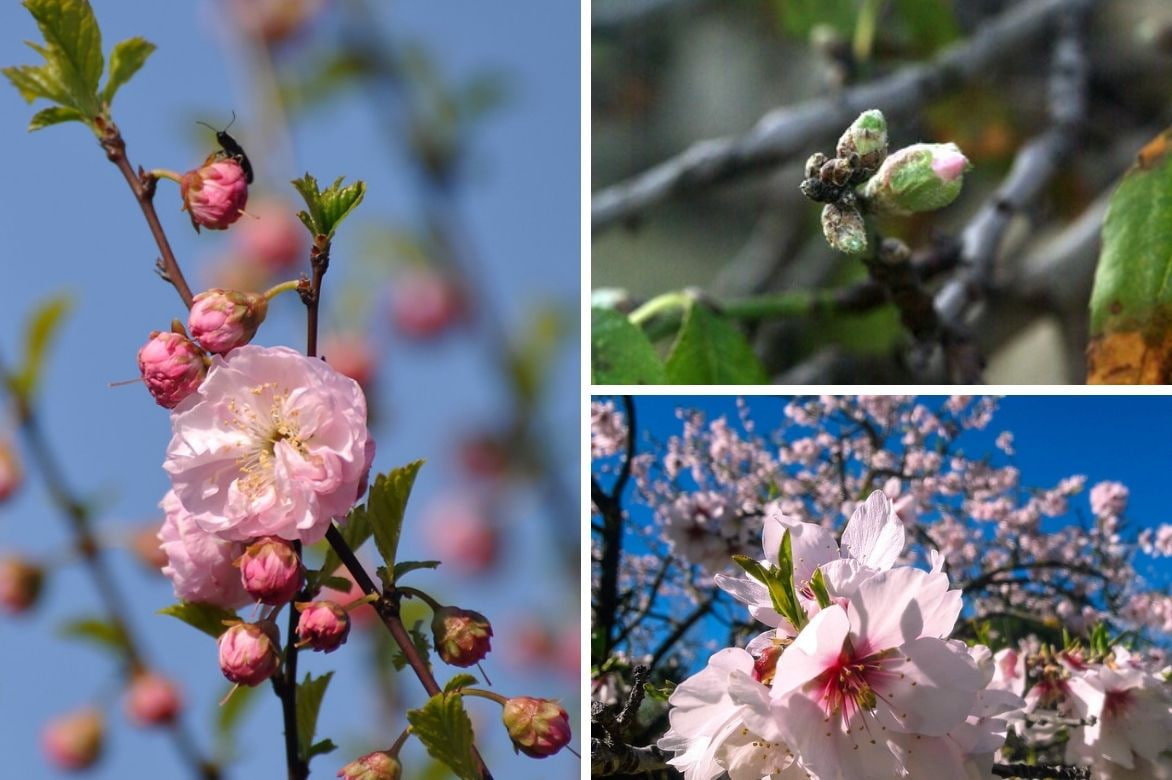 The flowering of the pinkish-white almond tree occurs from January to March depending on the varieties
The flowering of the pinkish-white almond tree occurs from January to March depending on the varieties
Most almond trees are self-sterile, meaning they do not fertilise their own flowers. This necessitates the planting of at least two different varieties to obtain fruit. Bees and bumblebees will take care of the pollination. Some varieties, such as the All in One Almond Tree or the Supernova Almond Tree, are self-fertile, while others, like the Princesse Almond Tree, are partially self-fertile.
On branches that are at least 2 years old, the almond tree produces oblong, compressed drupes that display lovely light green colours before turning dark brown. Inedible, velvety, and fleshy, these drupes split open to release a porous kernel with a more or less hard and woody shell. This kernel contains one or two seeds (the almonds), which are oblong and flattened, covered with a rough ochre integument. In wild almonds (Prunus amara), this almond is bitter because it contains two molecules, amygdalin and emulsin (as do all trees in the Prunus family) that can be toxic when consumed in large quantities. In contrast, sweet almonds pose no risk as selective breeding has reduced the concentration of amygdalin.
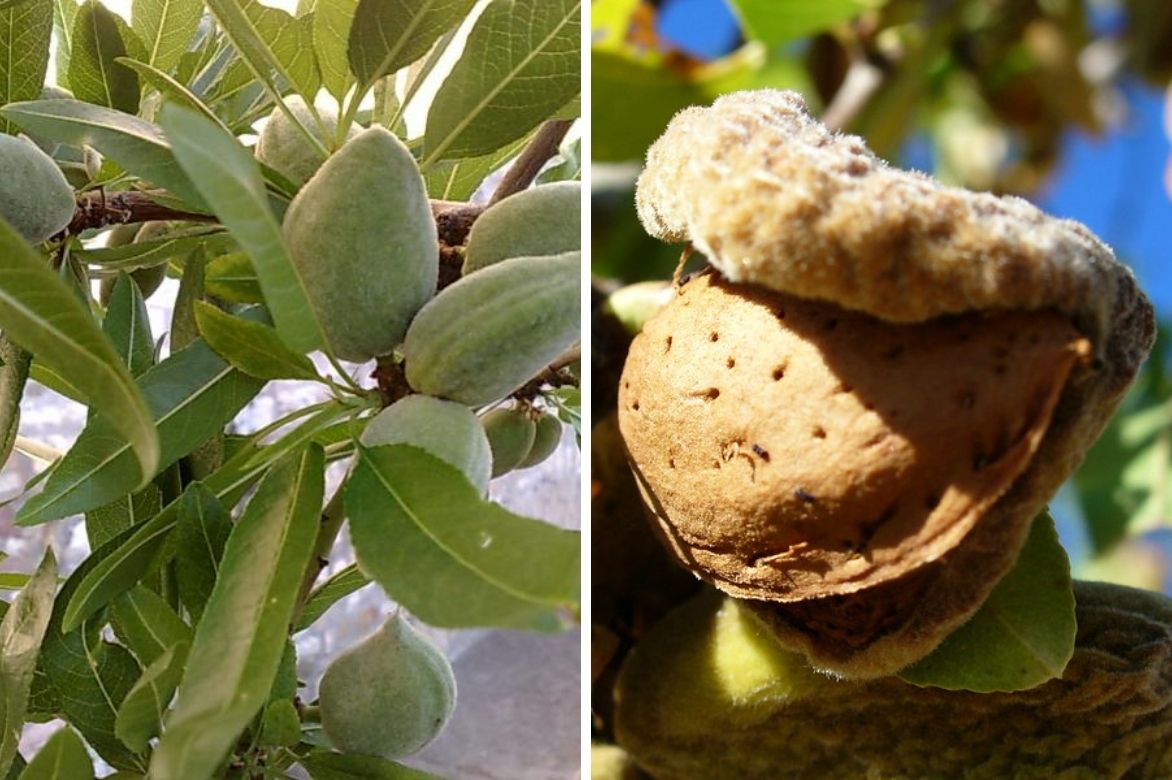 Initially velvety, the drupes of the almond tree take on brown hues and open at maturity to reveal the woody shell of the almond
Initially velvety, the drupes of the almond tree take on brown hues and open at maturity to reveal the woody shell of the almond
Almonds harvested in June-July are referred to as fresh, while those harvested in late August or September are dry.
The different varieties of almond tree
There are various varieties of almond trees that expand your planting options. They are primarily distinguished by their flowering, which can be early or late, a criterion to consider if you live south of the Loire. Similarly, some almond trees will be more susceptible than others to diseases and pests, while others will be self-sterile and will require the planting of at least two trees. Finally, some will have a quicker fruiting period.
There are many traditional and ancient varieties typical of Provence: Dame de Provence, Aberrane d’Aureille, Dorée or Demi Tendre d’Apt, Demi Tendre de Riez, Languedoc, Beraude Dure, Princesse, Tournefort, or Aï, an ancient variety used in the Aix-en-Provence region since the 19th century with a rapid fruiting period. Some varieties have Spanish origins, such as Bartre, Marcona, Mardia, or Penta, while others are American, like Carmel, Nec plus ultra, Non pareil, or Texas.
Other almond varieties have been obtained through cross-breeding different species: Ferraduel, Ferragnès, Ferrastar, Lauranne, Mandaline… are relatively recent creations from INRA.
The conservatory orchard of almond trees in Apt, located near the Moulin de Salignan, features around forty different varieties, both old and new, and more than 150 trees. Open to the public, this orchard is a true delight in early spring.
Our favourite varieties
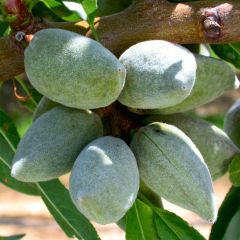
Prunus dulcis All In One - Almond Tree
- Flowering time April
- Height at maturity 8 m
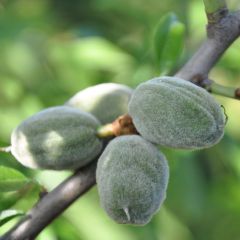
Prunus dulcis Supernova - Almond Tree
- Flowering time March, April
- Height at maturity 5 m
For pot growing
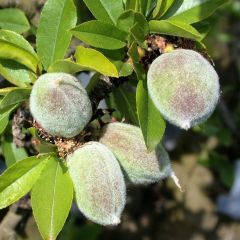
Dwarf Almond Garden Prince
- Flowering time March
- Height at maturity 2 m
Discover other Almond trees
View all →Available in 2 sizes

Available in 2 sizes
Available in 3 sizes
Available in 1 sizes
Available in 1 sizes
Available in 2 sizes
Available in 1 sizes
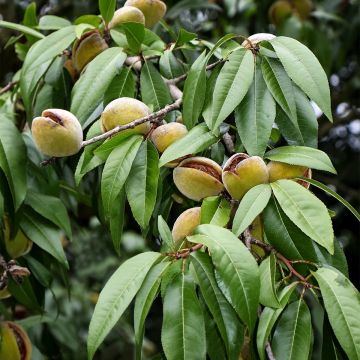
Available in 2 sizes
Available in 1 sizes
Available in 1 sizes
Planting the almond tree
Where to plant?
In terms of soil, the almond tree has few requirements. All soils are suitable, although it does have a slight preference for calcareous soils. It can thrive in stony, arid, and dry soils. The almond tree is well-equipped to withstand drought.
However, these soils must be light, deep as the almond tree has a taproot system, and above all, extremely well-drained. Wet soils are not suitable at all.
In terms of location, it should be very sunny, and especially sheltered from draughts, frosts, and cold winds. This is why planting in the south is preferable. North of the Loire, the almond tree has little chance of bearing fruit.
When to plant?
Autumn planting is recommended and will allow the almond tree to establish itself well before spring. Moreover, it is very early and comes into leaf quite soon.
How to plant?
Almond trees are sold as bare roots or in containers.
- Carefully weed and remove stones from the designated area for the almond tree
- Loosen the soil deeply with a fork
- Add some sand if you find the soil too heavy
- Dig a hole 50 to 60 cm deep and 80 cm wide
- Throw a handful of crushed horn at the bottom of the hole and mix it with the soil
- Add some of the extracted soil mixed with well-decomposed manure
- Place a stake to keep the tree upright
- Install the almond tree so that the collar is level with the soil
- Fill in around the planting area and firm it down
- Water generously
If your almond tree is bare-rooted, remember to dress and praliné them before planting. Dressing means cutting the tips of the roots, and praliné means soaking them in a mixture of one-third garden soil, one-third compost, and one-third rainwater. Pralinage helps eliminate air pockets between the roots and the soil.
Allow at least 15 metres between each almond tree.
Growing an almond tree in a pot is possible
Provided you choose a dwarf almond tree like Garden Prince. Choose a pot that is deeper than wide and place a good layer of gravel or clay balls at the bottom. Fill the pot with a mixture of 2/3 garden soil and 1/3 potting soil. Position your pot in the sun and water regularly. A fertiliser application is recommended in spring.
Maintenance, pruning and harvest
The first year after planting, it is essential to water, especially during hot weather.
Each year, apply fertilisers to your almond tree. In autumn, apply compost by surface scratching, and in spring, give your almond tree a special fruit tree fertiliser. As a preventive measure, a treatment with Bordeaux mixture can also be applied to prevent the development of fungal diseases.
Pruning the almond tree
The year following planting, pruning is unnecessary, and the almond tree can develop freely. This is especially true as flowering occurs on 2-year-old branches, or even 1-year-old branches for some varieties.
Maintenance and formative pruning should be done in autumn. The aim is to aerate the branches and facilitate sunlight penetration, renew the branches, and remove those from the centre. Pruning also helps eliminate dead branches, suckers, and drageons. It is advisable to apply a healing agent after pruning.
Almond trees can be trained as half-standard or low-standard goblets, devil’s palmettes, or cordons.
Harvesting almonds
Fresh almonds are harvested from June or July, depending on the variety, about twenty days before they reach ripeness. Milky, they should be consumed immediately. At the end of August to early September, almonds are harvested (hulled) when dry, as the drupe splits and begins to open. To store them, the drupe must be removed to reveal the woody shell. They can be kept for a year in a cool, airy place.
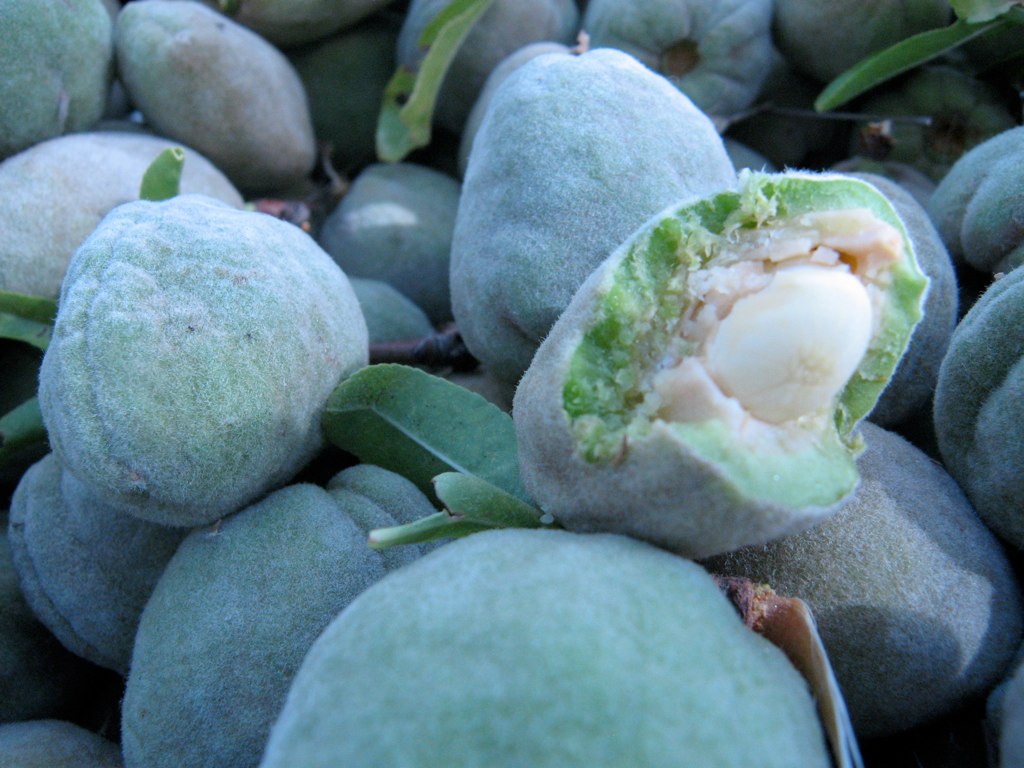 Harvested fresh, almonds are milky</caption]
Harvested fresh, almonds are milky</caption]
Diseases of the almond tree
The almond tree is susceptible to numerous fungal and bacterial diseases. Similarly, a number of pests can attack it.
Among the diseases, the most common are moniliosis, which causes the wilting of flowers and the appearance of cankers on the branches, and peach leaf curl, characterised by the deformation and discolouration of leaves. Another cryptogamic disease affecting the almond tree is coryneum blight or shot hole disease. This fungus attacks the leaves, branches, and fruits, leading to the decline of the almond tree. Verticillium wilt can also affect the almond tree as well as other fruit trees. It manifests as browning and curling of the leaves. One may also encounter fruit tree rust, scab, anthracnose, and red spot disease.
The pests primarily include the red spider mite of the almond tree and the almond bud midge, the peach leaf miner, and green aphids.
→ Learn more about the diseases and pests of the almond tree in our article.
How to propagate the almond tree?
To propagate the almond tree, several techniques can be applied: sowing for amateur gardeners, grafting or budding for the more experienced.
Sowing almonds
The first step is to select a nice almond shell that you will keep. To germinate, this almond needs to undergo a period of cold to break its dormancy. There are two options: either you sow your almond in autumn and let it spend the winter outdoors, or you sow it in spring after storing it in the refrigerator for 1 to 2 months.
In any case, before planting it, it is necessary to soften the shell by soaking it overnight in water at room temperature. Next, prepare a deep pot with a layer of clay balls or gravel at the bottom. Fill it with one-third garden soil, one-third potting soil, and one-third sand, and place your almond stone with the tip facing up. Cover with 2 to 3 cm of soil and water to keep the substrate consistently moist. As spring arrives, take the pot outside and place it in partial shade.
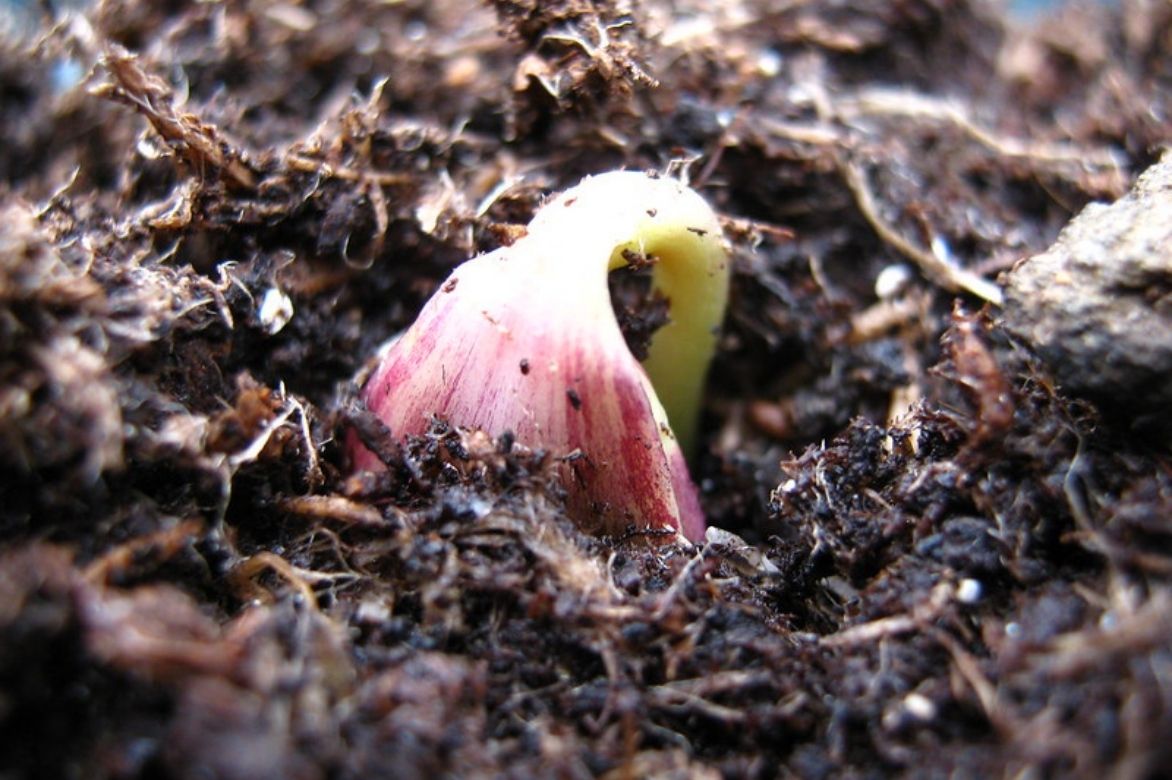 Propagation of the almond tree can be done by sowing
Propagation of the almond tree can be done by sowing
When the seedling reaches about 30 cm, repot it into a larger pot with special potting soil for Mediterranean plants. By autumn, you can plant it in its final location. Ideally, sow several shells of different varieties to ensure pollination, as most almond trees are not self-fertile.
Grafting
The best grafting technique for an almond tree is known as “budding.” This is a shield graft performed in August during the time of budding, when trees prepare for winter by lignifying.
- Take a one-year-old almond scion
- Trim the leaves while keeping the petioles
- Select a smooth part on a one-year-old, but lignified, branch of a two-year-old rootstock (a seedling almond, a seedling apricot, a seedling peach, or a seedling plum)
- Make a horizontal and then vertical incision in a T shape on the branch of the rootstock
- Make a horizontal cut 2 cm long on the scion, below the bud, then make a cut from the incision to the bud
- Insert the bud into the T-shaped slit of the rootstock
- Wrap the bud with raffia.
What to plant with an almond tree?
By planting two or three almond trees, you will create an orchard. Remember that most almond trees are self-sterile, so it is necessary to plant different varieties. Thus, the Ferraduel almond tree can be pollinated by another variety such as Ferragnes, Ferragnes by Ferraduel, Aï, or Texas. The Texas almond tree is, in fact, a very good pollinator. Plant them at a maximum distance of 15 metres apart.
In an orchard, the almond tree can also be associated with olive trees, which require the same cultural conditions as it does, or a peach tree. The almond tree is also stunning when planted alone; its flowering will be enhanced if you plant bulbs such as daffodils or snowdrops at its base. Additionally, pair the almond tree with a Bodnant viburnum, which produces clusters of bright pink flowers in bud, then white or pale pink in the heart of winter.
Almond, a fruit with multiple benefits
Known since ancient times for its medicinal properties, the almond is also beneficial for our well-being. While almonds are indeed high in calories (400 Kcal/100g), they contain lipids, primarily mono-unsaturated fatty acids such as Omega-9, which are good fats useful for the cardiovascular system.
Almonds are also rich in fibre, protein, vitamin E (an antioxidant), and nutrients such as magnesium, calcium, and potassium.
As for the bitter almond tree, it produces bitter almonds that contain amygdalin, which becomes toxic after chewing. It produces cyanide, which is toxic in high doses. However, bitter almonds used in food production, in health and wellness products, or in perfumery pose no risk.
The various uses of almonds
Almonds can be consumed whole, blanched (i.e., stripped of their integument), or sliced, ground into powder, or made into paste. They can be roasted and/or salted. They are also enjoyed in the form of plant-based drinks or almond paste. Almonds are incorporated into dragées, nougats, croquants, and serve as a base for making frangipane.
Bitter almonds were used to make orgeat syrup and are still the basis for amaretto, an Italian liqueur. In Italy, one can also enjoy amaretti, delicious little biscuits.
Almond milk with orgeat syrup
Making your own almond “milk”…
Smooth and delicious, almond “milk” is lovely on its own, in desserts, smoothies, or milkshakes. It is also very simple to prepare.
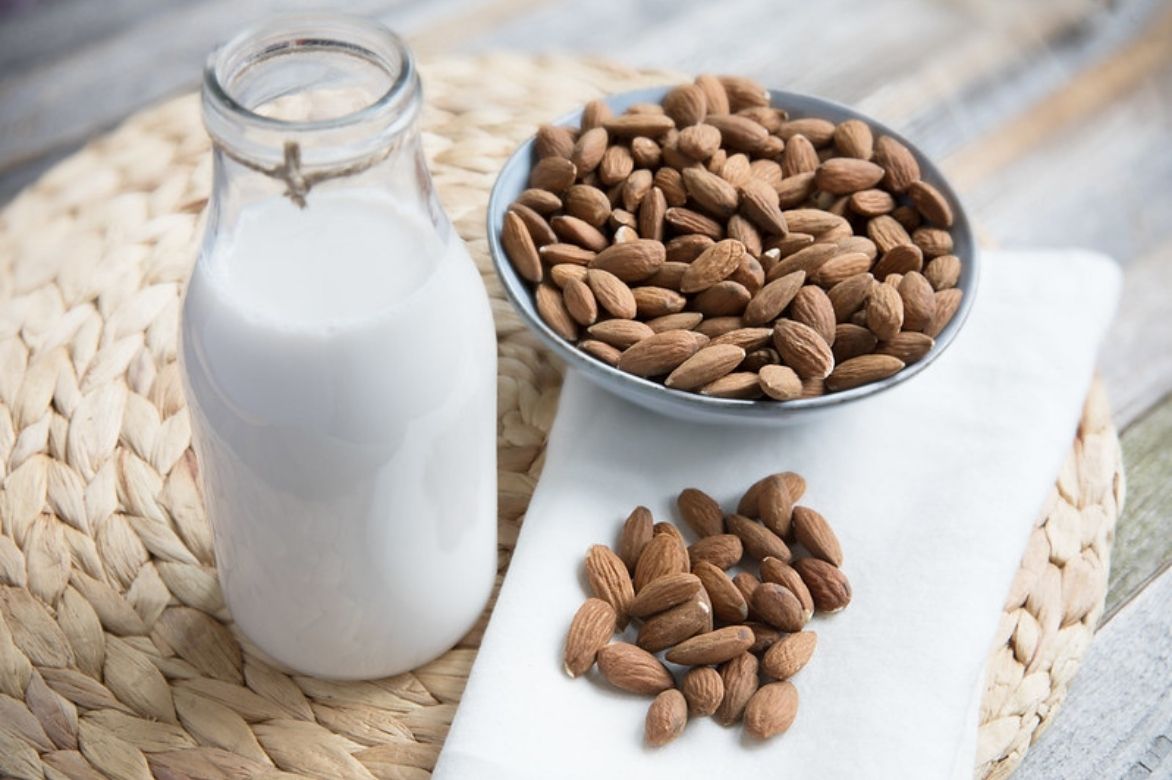
Almond milk is sweet and aromatic
My recipe:
- Soak 500 g of blanched almonds in water for an entire night
- Drain and rinse the almonds
- In a blender, combine the 500 g of almonds and 500 ml of water
- Blend for 2 minutes on maximum power
- Strain to remove the residue
… Or natural orgeat syrup
Historically, orgeat syrup was made from fermented barley with almonds added for flavour. Today, industrial orgeat syrups contain no barley and even less real almonds! However, you can make your own orgeat syrup at home. Simply mix 160 ml of almond milk, 120 g of sugar, 2 teaspoons of bitter almond flavouring, and 4 drops of orange blossom extract, then heat gently until boiling.
Virginie tells you all about the magnificent flowering almond, also known as the Chinese almond, a beautiful ornamental bush that, like its cousin, heralds the arrival of spring: Flowering almond, Chinese almond: planting, pruning, care
If you are interested in growing fruit trees, we invite you to read the articles from our specialists regarding planting, pruning, staking…
Find all of Sophie’s tips on how to harvest and store almonds.
Discover our article: Growing shell fruits in the garden
Also discover 7 Mediterranean trees in our article.
How to choose the right almond variety? in our article and Almonds: the best varieties to plant.
- Subscribe!
- Contents































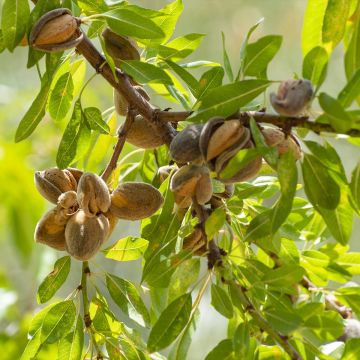

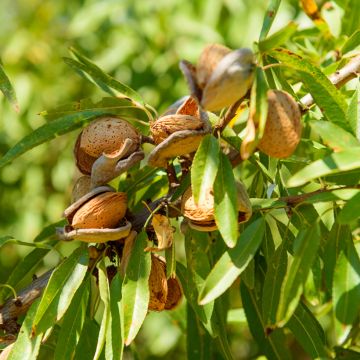
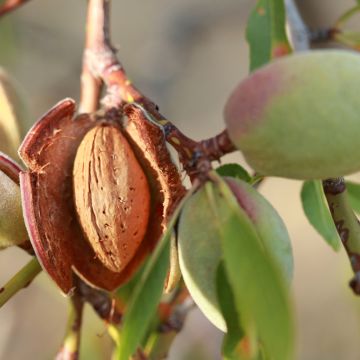

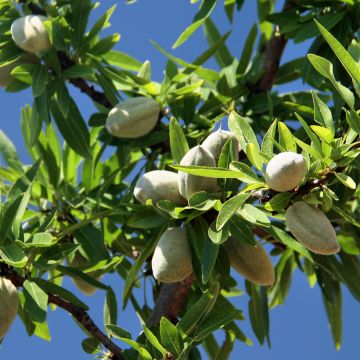

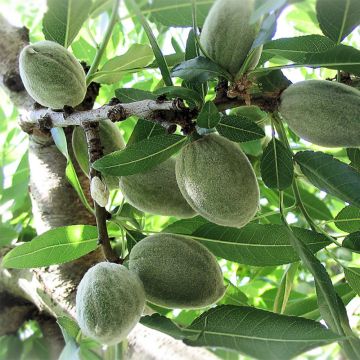
Comments